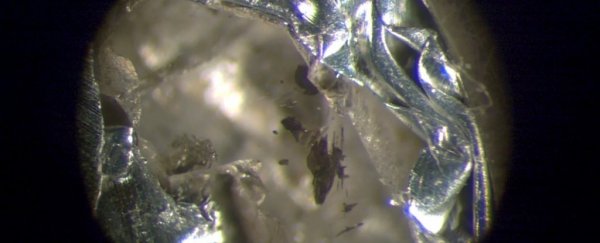While humanity keeps reaching further and further towards the stars, a place much closer to home remains completely inaccessible to us.
There's only so far we can reach into the ground, meaning the best we can do is speculate on what makes up so much of our planet deep beneath our feet.
But every now and again, the planet itself coughs up flawed diamonds that have swallowed tiny samples of some of our world's more exotic minerals.
Now, for the first time ever, one of these diamond capsules has transported a naturally occurring calcium silicate mineral from Earth's lower mantle (which makes up more than half of our planet's volume), and still preserved in its high-pressure form – in spite of its epic journey of more than 660 kilometers (410 miles) from below the surface.
"Such direct sampling of the inaccessible lower mantle would fill our knowledge gap in chemical composition and [variability] of the entire mantle of our planet," geochemist Yingwei Fei from the Carnegie Institution for Science explains in a commentary on the new research, which is reported in Science.
Named davemaoite by University of Nevada mineralogist Oliver Tschauner and colleagues, this calcium silicate (CaSiO3) perovskite confirms 50-year-old theories of its existence.
Calcium silicate exists naturally in various structures. Wollastonite is the common structure this team of elements create when clumped together in relatively low pressure. Wollastonite forms breyite under intermediate pressure – which is the second most abundant inclusion found in deep Earth diamonds.
But theory suggests there is another way breyite might form.
Under the pressure levels found in Earth's lower mantle, 660 to ~2,700 km deep, these atoms arrange themselves into the cubic perovskite structure. This usually reverts to another form once the pressure is eased, which also may be how some of the breyite carried by the diamonds came to be.
Synthetic CaSiO3 reverts to glass once the intense laser pressure used to form it is relieved.
This "garbage can" crystal is what makes davemaoite of geochemical interest. The shape and the pressure that creates it, force together elements that wouldn't ordinarily be found in each other's company. This includes heat-generating thorium and uranium, with half-lives longer than Earth's entire geological history.
"Our observations indicate that davemaoite also hosts potassium in addition to uranium and thorium in its structure," Tschauner and team write, explaining this means davemaoite's abundance influences how much heat is in the deep mantle.
In turn, its heat and distribution determines how Earth's deep crust is recycled, where heat anomalies arise, and the state of the magma at the base of Earth's mantle.
A type of CaSiO3-perovskite was previously discovered in 2018, and although it was an exciting candidate, its properties did not quite add up. The researchers suggest that its current structure may have been shaped in retrograde – that is, during its uplifting rather than its initial formation.
This newly analyzed sample, trapped by a diamond found in the mine at Orapa, Botswana, was confirmed to have the predicted structure through synchrotron X-ray diffraction.
Laser mass spectrometry revealed almost half of the davemaoite's calcium has been replaced by other elements – mostly potassium. Tschauner and team suspect this may have helped preserve its structure along with the residual pressure still found in the diamond.
They argue its low levels of titanium and high levels of potassium indicate it did indeed form within the hot pressured depths of Earth's lower mantle.
Davemaoite has been officially recognized as a new natural mineral by the Commission of New Minerals, Nomenclature, and Classification of the International Mineralogical Association.
This research was published in Science.
